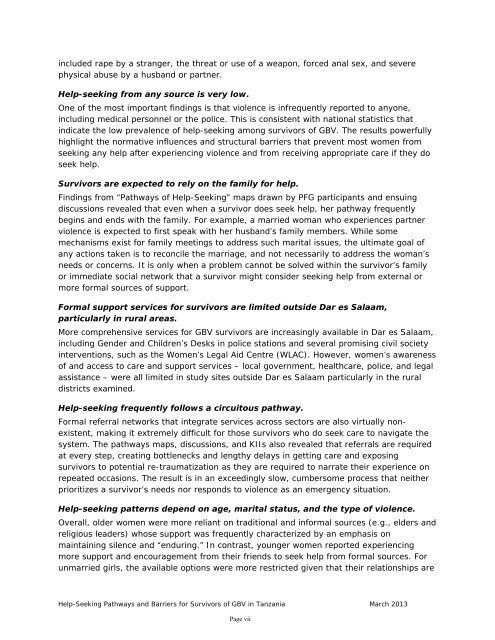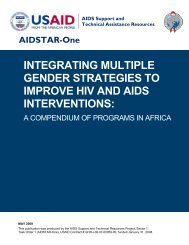Download PDF - ICRW
Download PDF - ICRW
Download PDF - ICRW
You also want an ePaper? Increase the reach of your titles
YUMPU automatically turns print PDFs into web optimized ePapers that Google loves.
included rape by a stranger, the threat or use of a weapon, forced anal sex, and severe<br />
physical abuse by a husband or partner.<br />
Help-seeking from any source is very low.<br />
One of the most important findings is that violence is infrequently reported to anyone,<br />
including medical personnel or the police. This is consistent with national statistics that<br />
indicate the low prevalence of help-seeking among survivors of GBV. The results powerfully<br />
highlight the normative influences and structural barriers that prevent most women from<br />
seeking any help after experiencing violence and from receiving appropriate care if they do<br />
seek help.<br />
Survivors are expected to rely on the family for help.<br />
Findings from “Pathways of Help-Seeking” maps drawn by PFG participants and ensuing<br />
discussions revealed that even when a survivor does seek help, her pathway frequently<br />
begins and ends with the family. For example, a married woman who experiences partner<br />
violence is expected to first speak with her husband’s family members. While some<br />
mechanisms exist for family meetings to address such marital issues, the ultimate goal of<br />
any actions taken is to reconcile the marriage, and not necessarily to address the woman’s<br />
needs or concerns. It is only when a problem cannot be solved within the survivor’s family<br />
or immediate social network that a survivor might consider seeking help from external or<br />
more formal sources of support.<br />
Formal support services for survivors are limited outside Dar es Salaam,<br />
particularly in rural areas.<br />
More comprehensive services for GBV survivors are increasingly available in Dar es Salaam,<br />
including Gender and Children’s Desks in police stations and several promising civil society<br />
interventions, such as the Women’s Legal Aid Centre (WLAC). However, women’s awareness<br />
of and access to care and support services – local government, healthcare, police, and legal<br />
assistance – were all limited in study sites outside Dar es Salaam particularly in the rural<br />
districts examined.<br />
Help-seeking frequently follows a circuitous pathway.<br />
Formal referral networks that integrate services across sectors are also virtually nonexistent,<br />
making it extremely difficult for those survivors who do seek care to navigate the<br />
system. The pathways maps, discussions, and KIIs also revealed that referrals are required<br />
at every step, creating bottlenecks and lengthy delays in getting care and exposing<br />
survivors to potential re-traumatization as they are required to narrate their experience on<br />
repeated occasions. The result is in an exceedingly slow, cumbersome process that neither<br />
prioritizes a survivor’s needs nor responds to violence as an emergency situation.<br />
Help-seeking patterns depend on age, marital status, and the type of violence.<br />
Overall, older women were more reliant on traditional and informal sources (e.g., elders and<br />
religious leaders) whose support was frequently characterized by an emphasis on<br />
maintaining silence and “enduring.” In contrast, younger women reported experiencing<br />
more support and encouragement from their friends to seek help from formal sources. For<br />
unmarried girls, the available options were more restricted given that their relationships are<br />
Help-Seeking Pathways and Barriers for Survivors of GBV in Tanzania March 2013<br />
Page vii

















